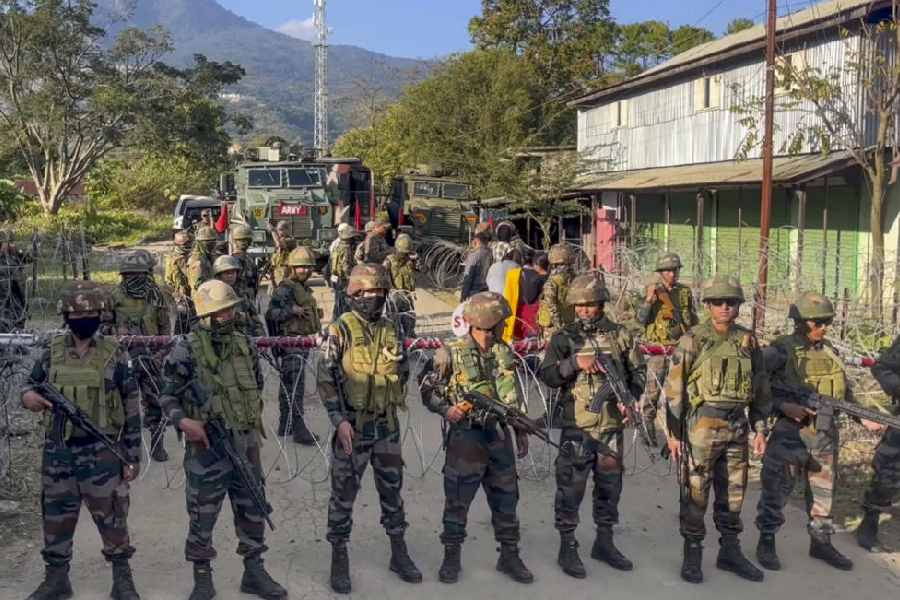What association does a Calcutta-based culture aficionado have with wild leopards in a nondescript landscape called Bera, located in the south-western part of Rajasthan? Sundeep Bhutoria’s latest book The Bera Bond (Pan Macmillan India), happens to be a racy account of these wild mammals that roam around shepherds, called Rebari in local parlance. It deciphers the human-wildlife association. Their number has increased in the past decade or so. Has poaching declined? Significantly, because shepherds do not mind if one of their lambs is stealthily usurped by the crafty and opportunistic predator that usually follows their herd. They consider it as their divine bond.
So Bera is basking in leopard glory. It has become the most promising location for camera buffs. At dawn and dusk, wait around crevices among granite hills, amidst euphorbia bushes, around huts, and you will have a tete-a-tete with a not-so-shy animal. It is also often found resting on the steps of a temple. The ‘pujari’ (caretaker) has been photographed standing along with a female resting over a rough boulder, within the same premises. Bag full of photos of females with cubs, dominating males gnawing at a camera and for a lucky shutterbug, the male covering the female. Open for all. No entry fee, no fee for camera, and one is free to do a movie. A heaven for wildlife lovers, it is neither a national park nor a sanctuary.
Bera’s ecology has been woven like a folk tapestry. Jawai dam, created by the ruling family of Jodhpur, nay Marwar, finds full-throated mention as the consequential survival equity for humans, livestock, wild mammals, birds, etc. Migratory and resident birds at this waterbody have been showcased and named appropriately. An extremely clear photo of this strictly nocturnal Rusty-spotted Cat is there. Indian Courser is a fascinating bird thriving only across short-arid-grass habitats. Its sub-adult has been photographed here.
Sundeep has researched to present details, with photographs, of all the wild cats. He felt the local leopards are far-off cousins of Mt. Abu’s stock. This far-flung plain habitat forms a triangle with Ranakpur-Udaipur on one side and Sirohi on the other. Both regions, dotted by the Aravali ranges and replete with dry deciduous forests, hosted tigers until half a century ago.
The rural scene has been portrayed at ease. Multi-coloured skirts and polka-dot blouses for the women. Men are in white clothes donning blood-red turbans. They sport floating moustaches, wear gold ear-rings and utter: our leopards caused you to visit this place. They are tall, hardy, handsome and smiling. Each one carries a long baton, the lone weapon to shoo off a lurking predator. They derive pride in what they do, and lead a pastoral life. Milk sale is their main economy.

Only half-a-dozen hotels make up the hospitality sector here. For his leopard encounters, Sundeep preferred the Bera Safari Lodge. The location is awesome – easy to spot a predator from one’s room as well. He describes its owner, Shatrunjay Singh, as a fierce conservationist running a tirade against stone quarries illegally operating there. One of Shatru’s forefathers ruled as Rana of Umarkot, located in Northern Sindh province. He humbly gave shelter to emperor Humayun, who was on the run from India following recurring defeats. The Mughal’s wife gave birth to a male child at Rana’s palace. The boy was to become emperor Akbar.
“Bera holds out hope of a remarkable turnaround through a community-led conservation initiative,” says the writer, striking an optimistic note. In the same vein, he questions as to why Bera has not been declared a Community Reserve to let local stakeholders receive economic benefits from leopard-based tourism? The answer has to be sought from Rajasthan’s forest department, whose couple of officers have been cited in this text, along with their photographs.
The coffee-table, hard-bound, 160-page document looks like a bible for this least-sung predator in India. Neelam, Pasha, Zia, almost each one has been named. Wonder how one would identify all. It is often a hide-and-seek melee-like situation when the animal is spotted. It marks its attendance, for minutes only. CP Singh Rathore, Gopal Singh and Umesh Gogna have been acknowledged for their photography. The Bera Bond is truly a promotional enterprise as described by the author, “My only intention behind writing this book is to inspire people to save the big cats.” He prefers to dedicate it to his daughter Aavya.
- The writer, into wildlife conservation for decades, is also the organiser of Indian Birding Fair since 1997, and is based in Jaipur











